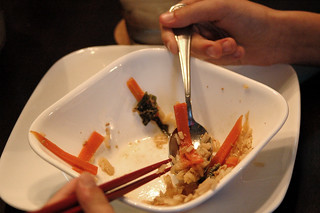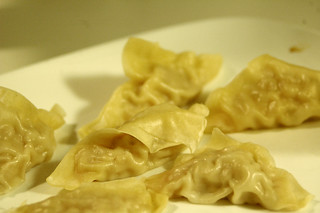Yesterday, I needed a quick recipe to make because I was running out of time to make supper. So I went flipping through my trusty recipe book "Let's Cook Japanese Food!" and landed on the recipe for Yakisoba and I remembered that we have some napa cabbage that was in dire need of being used.
 I gathered everything for the meal, which isn't much: only half a head of cabbage, 1/2 a large carrot (or a whole small one), and 1/2 a yellow onion.
I gathered everything for the meal, which isn't much: only half a head of cabbage, 1/2 a large carrot (or a whole small one), and 1/2 a yellow onion.I chopped it all up as I thawed the pork chops. Technically the recipe in the book calls for 6 pieces of thick cut bacon, but as my family likes more meat in our dishes (and we normally don't have bacon on hand) I thaw a pork chop or two and slice them into thin pieces instead. Hey, bacon is pork after all, so it tastes the same.
 So once the veggies were ready, I sliced the pork chops. I ended up only using 1 1/2 because one of them was gigantic. It was shoved back into the freezer for another day. Once sliced, I tossed the meat in a large frying pan (the key word here is large because this dish will overflow the pan if you don't use one that is big enough) with a tablespoon or two of oil.
So once the veggies were ready, I sliced the pork chops. I ended up only using 1 1/2 because one of them was gigantic. It was shoved back into the freezer for another day. Once sliced, I tossed the meat in a large frying pan (the key word here is large because this dish will overflow the pan if you don't use one that is big enough) with a tablespoon or two of oil. While the pan started heating up, I pulled out two bundles (3.5 oz each dry) of soba noodles. This is only about half the noodles that the recipe calls for, but I know from cooking this before that 1) we don't need all those noodles and 2) they typically make the pan overflow. I used normal soba noodles, but yakisoba noodles are best.If you have neither, spaghetti noodles work great. But, soba noodles of some form are the best. So, I boiled the noodles until al dente and quickly drained them. You do NOT want soggy noodles. Trust me.
While the pan started heating up, I pulled out two bundles (3.5 oz each dry) of soba noodles. This is only about half the noodles that the recipe calls for, but I know from cooking this before that 1) we don't need all those noodles and 2) they typically make the pan overflow. I used normal soba noodles, but yakisoba noodles are best.If you have neither, spaghetti noodles work great. But, soba noodles of some form are the best. So, I boiled the noodles until al dente and quickly drained them. You do NOT want soggy noodles. Trust me. By the time the noodles are cooked, the pork was fairly well done so I tossed in the veggies. The recipe said to stir fry them for only around 2 minutes but I typically do it longer until I can see that the veggies are starting to soften (and that the pork is finally done).
By the time the noodles are cooked, the pork was fairly well done so I tossed in the veggies. The recipe said to stir fry them for only around 2 minutes but I typically do it longer until I can see that the veggies are starting to soften (and that the pork is finally done).The noodles came next and I stirred them well into the mixture. Then, I poured in the 1/4 cup water and covered it for the minute in the recipe and then stirred until the water boiled off.

The final step is the fun one where you season it to taste. I've never managed to find Yakisoba sauce which is ideal (if you have it, use 1-2 tablespoons). I typically substitute 2 tablespoons Worcestershire sauce and then 1-2 additional tablespoons of soy sauce to taste. I stirred all that in, and then added a sprinkle of pepper and salt (again, do it to taste).
One final thorough stir and it was done. Doesn't it look good? The noodles were a bit soggy because I let them sit too long, but other than that it was great.





